
“What’s your favorite song?” Marvin asks a guest after inviting him to take a turn grinding corn in the yard behind the Randolph House. It’s one of many unexpected surprises guests will encounter in the reimagined Historic Area.
Marvin, portraying an enslaved member of the Randolph household, smiles at the suggestion of Bohemian Rhapsody. He begins to improvise a simple work song, using the rhythm to alleviate the drudgery of labor. The guest takes a turn, asking who would have done this work, and why you couldn’t just mill the corn, and how much exertion the task required. And, and…
“And” is the idea. Programs, interpreters, and hands-on opportunities have been rearranged to promote deeper engagement, especially in select sites across the Historic Area. These changes (which we previewed a few months ago) are now underway. This overview should help you navigate the new look.
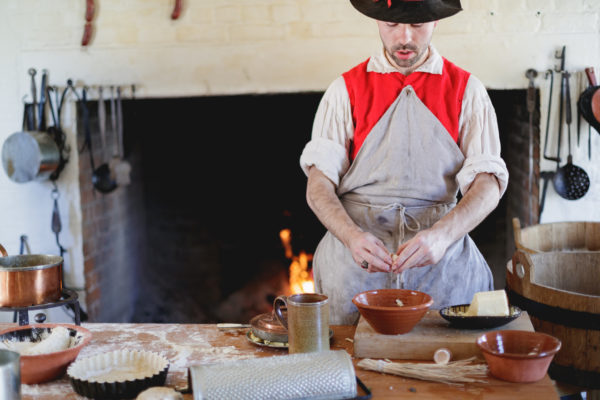
The changes include new programs at the beginning and end of the day, expanded hours in many trade shops and other sites, more activity in the iconic Raleigh Tavern, and more immersive experiences at the Geddy House, Wythe House, Randolph House, and Public Armoury.
There are countless stories to tell—of how 18th century Virginians lived, learned, fought, and aspired to better futures. So here’s your overview of how to plan your visit, with an emphasis on what’s new.
Getting Started
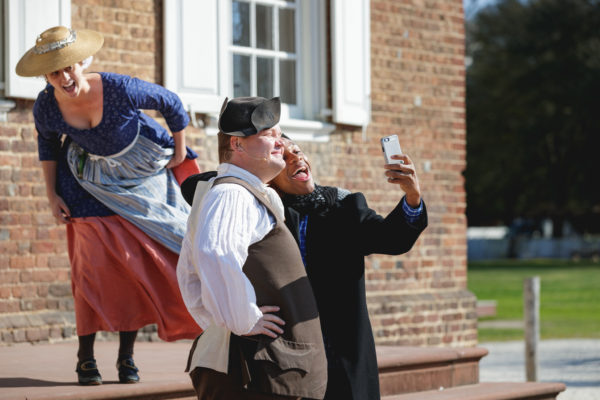
If you’re taking the bus from the Visitor Center (which we recommend!), hop off at the Market House, which is your gateway to the 18th century. You’ll be greeted by interpreters who can help you find your way if necessary, and you’ll be just steps from the action.
Start your Historic Area visit with Welcome to Williamsburg, a new 10-minute program in front of the Courthouse on Market Square, which offers a quick entertaining primer on how to make the most of your visit. It’s especially useful for first-time visitors. Check the schedule for times; it currently runs at 9:30, 10, and 10:30 a.m. daily.
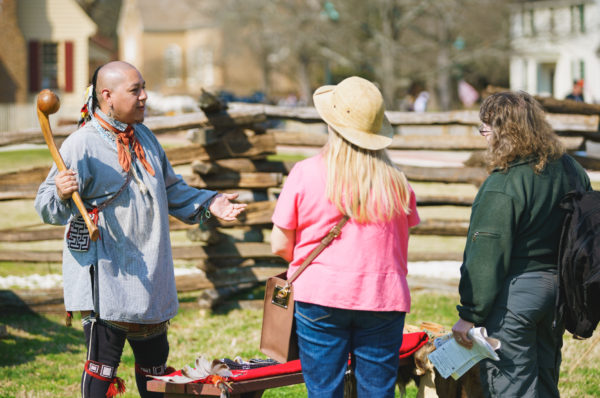
You might notice that the Military Encampment is now steps away. Stop by to chat with members of the Virginia State Garrison Regiment. The Indian Delegation has also set up camp there as they visit Williamsburg on a diplomatic mission. Learn more about their lifeways and their relationship with the colonists before heading farther into the city.
Geddy House
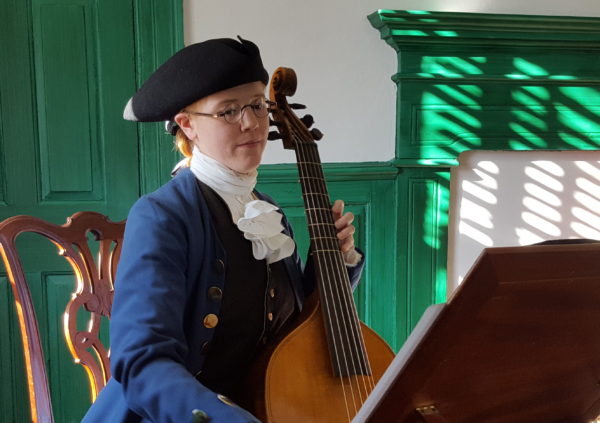
If you liked visiting the Powell House, you’ll love the Geddy, which is now open all day, every day. Step into the busy home of a well-to-do family at the crossroads of the capital city, where Palace Green meets Duke of Gloucester Street.
James Geddy was a successful silversmith. Entering the home, you’re in his place of business. The foundry is out back (don’t forget to stop in), but this first room is where he does business. See some of the work, learn about the business, and try counting out some 18th-century money before passing through into the family’s personal space in the house.
Once you’re in the domestic spaces, you’re part of the family. Try out an 18th-century bed, play games, do some chores, or find out what’s planned for dinner. Kids will love this immersive experience.
There’s a stream of different visitors, making calls to do business or just pay a social visit. You never know who you might meet. Or what you might be asked to help out with.
Wythe House

The Wythe House and gardens are also now open seven days a week for the full day. Tours of the house are self-guided, but there are interpreters nearby who help explain how the family used the home. (So did General Washington, who used it as his headquarters in the weeks before the decisive Battle of Yorktown in 1781.) Barriers are in the process of being modified to allow guests to come further into the rooms.
A couple of the rooms have no barriers at all. In the first floor parlor, I sat for a few minutes to appreciate a musician practicing an 18th-century piece on her harp. You can also walk around Mr. Wythe’s second-floor study and admire the globe, microscope, and other scientific instruments that were the hallmark of an Enlightenment enthusiast.
I also met Theodorick Bland, who was working on an orrery (a model of the solar system) and musing about the possibility of intelligent life on Venus. Such are the people you might encounter.
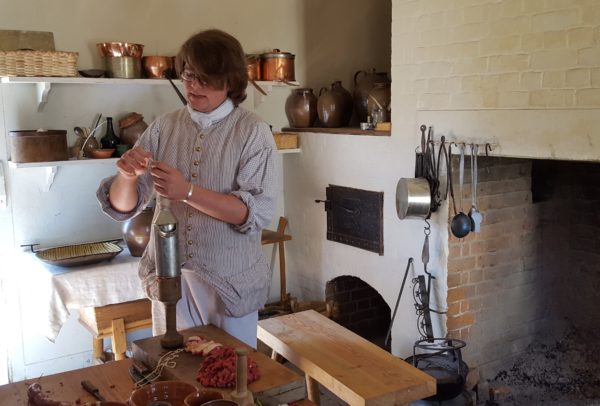
Outside, the garden should be in bloom before too long, but there’s much more happening in the yard now. You might find a table set up with the kind of scientific curiosity or experiment that would have been close to Mr. Wythe’s heart. The Wythe kitchen is open again, manned by staff from Historic Foodways. I watched Alan expertly stuffing sausage casings while fielding questions about the dishes prepared on a nearby table.
And now there’s a trade shop on the property, as the Coopers moved down from Nicholson Street. The property is now a hub of constant activity.
Randolph House
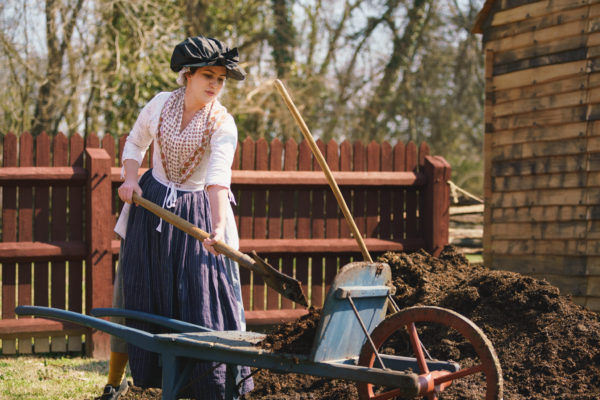
The household of Peyton Randolph is another site that has been restructured to offer a more intensive experience, tempting visitors to linger after touring the home. This home affords guests the opportunity to learn much more about the experience of enslaved African Americans, about 28 of whom lived here in the late 18th century.
The tour offers insight into the lives of all the people who lived there. In the yard in back, there are all sorts of happenings: food preparation in the kitchen, candle making, cow milking, and more. Don’t forget to ask Marvin if you can have a turn grinding corn with the mortar and pestle.
The Anderson Public Armoury
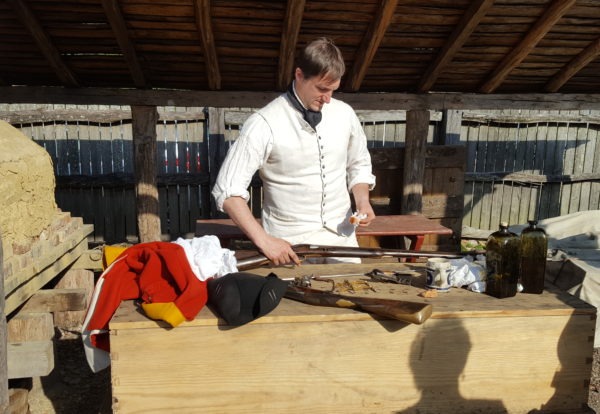
Anderson’s Public Armoury already had a lot going on, with the blacksmith shop, the military artificer, the tin shop, and the kitchen creating a small village of workers tending to the needs of the army. Now you’ll be meeting more individuals interpreting the historical people who might have had business there.
When I visited I encountered Col. James Innes working with Yorktown merchant John Hatley Norton to calculate the provisions needed along a route the army might take. When young people approached, they had them do the math on a small chalkboard, making them part of the story.
Meanwhile, Donald Fraser, a Scottish prisoner of war, worked nearby to repair weapons. With a rather poor attitude, if you ask me. But others seemed to find him entertaining enough to stay and converse for a while.
Soon there will also be an area in the rear of the lot where students can learn about simple machines, the basic forces, like levers and wedges, that are the scientific basis for so much of how 18th-century workers had to employ before other kinds of power made it easier. Look for that later in the spring.
Historic Farming
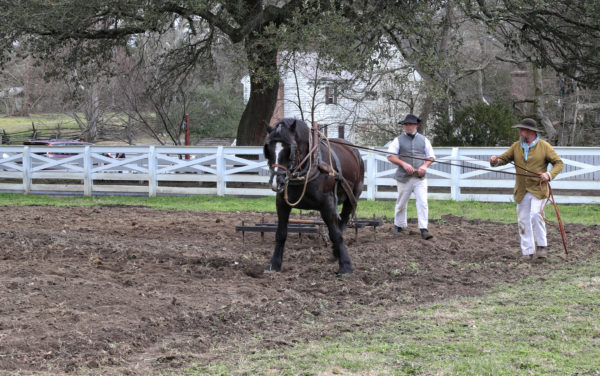
We’re starting to do more work farming within the city limits. Stop by to discover what’s going on in Mr. Prentis’ pasture, directly behind Prentis Store. This spring they will be planting small patches of corn, tobacco, cotton, and a little patch of turnips there.
Raleigh Tavern
Historic tradespeople will soon begin installing a front porch on the Raleigh Tavern as we follow through on what we learned from archaeological and archival research. But it will remain open during the construction, and there are changes inside, too.
Tours of the Raleigh are again being offered daily, and as you step into different rooms, you’ll learn about the historic discussions of rights and liberties—and perhaps also where we might have missed the mark—directly from the people who were there. People like Thomas Jefferson and James Madison, of course, but also regular folks who have something to say about the big ideas, too.
Daily Dramatic Programs

Every day offers 11 a.m. and 2 p.m. programs at both the Charlton’s Coffeehouse Stage and the Governor’s Palace Stage. Check the daily schedule for what’s on tap on a particular day. The rotation includes dramatic stories of patriots and loyalists, African Americans and Native Americans, Nation Builders and ordinary people trying to navigate a changing world.
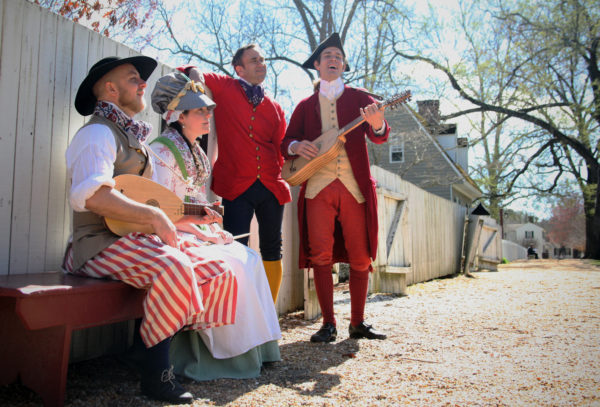
Don’t forget to check the marquee at the Playbooth Theater when you’re near Palace Green; there you’ll find a schedule of daily entertainments, including music and puppet shows.
The Day Isn’t Over Until You Say It’s Over
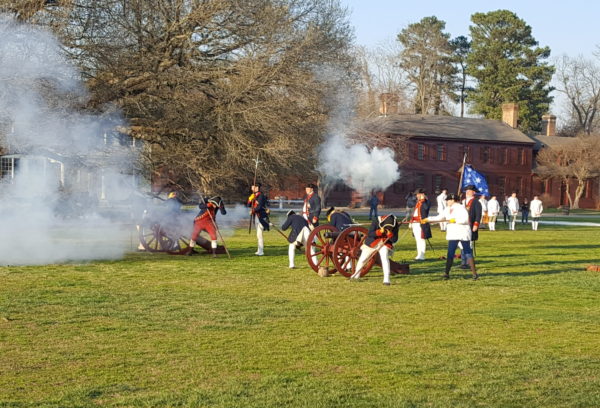
Circle back to Market Square at 5 p.m. for a bit of pageantry with Marching Into Evening. It actually starts with a bang as a cannon is fired on Courthouse Green at 4:50 p.m. as the Fifes and Drums march down DoG Street from the Capitol, then performs.
That closes out the day for most sites, but your visit isn’t even close to over. Stick around for a tavern dinner, an evening program, and shopping. Talk about what you experienced together, and all the new things to see.
One thing that hasn’t changed? You still can’t see it all in a day—or in a week, for that matter. We hope you’ll make time to come back soon, and let us know what you think.
Sue Tylka says
Last May during our visit there was a candle maker and a walking tour of finding some of the natural materials used in the process. We are again visiting this May. Will this be offered again?
The candlemaker has moved to a new home in the back of the Randolph House (next to the kitchen), so we don’t have that tour this year. But you’ll find candlemaking and much more going on at the Randolph.context for the that tour,
B. Fingerhut says
We absolutely LOVED Great Hopes when we visited last time… Is it true that it won’t be there anymore? The Slave Tour was stunningly real and meaningful. I hope that it will still be there when we return this year. Don’t make a mistake and let it go! We’ve never seen Colonial Williamsburg make an error… don’t let this be the first, please.
Great Hopes is still there to explore as a site and is used extensively by school groups, along with occasional evening programs. But in our effort to create a really strong core of activity in town, Ed has taken his farming talents closer to the heart of the Historic Area, currently planting the field behind Prentis Store.
The Carpenters are finishing up their building at the corner of Nicholson and Botetourt, and of course, the focus of our African American interpretation moved to the Randolph House a couple of years ago. It’s all dedicated to committing resources to telling the story of the colonial capital as effectively as we can.
As wonderful as the Great Hopes space is, the goal is to make the great work our interpreters do as easy as possible for our guests to take advantage of. Hope you will come see it for yourself soon, and let us know what you think. We appreciate the feedback!
I agree with Mark…I was also disappointed in the sale of Carter’s Grove and the abandonment of the Slave quarters there…Great Hope at least attempted to interpret the “middling sort” The town more or less shows the upper crust.
Great Hopes was just getting started good and now it’s over? Too much was invested there to just abandon it. it was never promoted vigorously…only in the last couple of years was there even a sign that said Great Hopes where the path started (across from the old entry building) to the visitors center. I hope they re-think this and let Great Hopes continue. I don’t think this new president really understands CW…he needs to observe more and ask for more input from long time interpreters who know what’s what.
Judy says
This makes me very sad. Our first experience at Great Hopes was last year and was definitely a highlight of our trip. We worked in the field and experienced a taste of just how difficult the work was, especially in the summer heat. We also learned a lot about building/roofing techniques.
I agree that it needed more publicity.
Great Hopes is not over! Yes, we’ve moved our farmers to do necessary work in town, but it is still used for groups and occasional evening programs. African American interpretation is stronger than ever, with the Randolph House, where nearly 30 enslaved people lived, being a particular focus. In addition, the carpenters who were there have their own building in town now, and soon they’ll be working on the new Raleigh tavern porch.
So, historic farming in town? Were they actually growing tobacco in town during the 18th century? I assumed only, or at least predominantly, garden crops were grown in town. Please let me know if I am mistaken. If I am correct, isn’t growing tobacco in town an inaccurate representation of 18th century Williamsburg?
Are there just signs at Great Hopes? If so, that would be a terrible mistake. Pretty much all of 18th century was rural. People who are not aware of that (and I suspect that may be significant chunk of Colonial Williamsburg’s visitors) may get a incorrect understanding of 18th Century VA if Great Hopes is deemphasized. How about interpretation of rural slavery? After all ,that is where almost all slaves lived. Interpretation of rural slavery suffered when Carter’s Grove was sold but at least it was preserved in some fashion at Great Hopes. Having a sign at the Great Hopes slave house would be a poor substitute for live interpreters. Many years ago, Colonial Williamsburg pretty much ignored half of the town’s population, which was black. It has done a GREAT JOB correcting that. Now is it going to ignore the much greater percentage of the colonial VA population, black and white, that was rural?
What will happen with the recently restored windmill at Great Hopes? Will it be ignored if Great Hopes is deemphasized? If I had contributed significant funds toward restoration, I would be sorely disappointed to see the windmill at a location with no live interpretation. Are there plans to move the windmill to the Randolph property? Wouldn’t that be ironic!
Are there just signs at the jail? I hope not. Doing something like that is going down the wrong road. I have seen signs in lieu of interpreters at some historic sites, more than a few buildings at Greenfield Village for example, and It creates a stale, as opposed to a vibrant , affect at those locations. Signs cannot answer questions.
Don’t get me wrong, what happened at Colonial Williamsburg is crucial to an understanding of American History. The foundation can tell the Colonial Williamsburg story while still educating people about how most Virginians lived. Token statements about how most of Virginians lived will go in and out of most ears. Colonial Williamsburg has always prided itself on authentically telling the story of Colonial Virginia. I hope that it will continue to do so.
Thank you for your comments. We’re trying a lot of new things, but everything is geared toward making the full range of experience as robust and accessible as possible. Historic farming’s move into town actually promises additional benefits besides making it easier for guests to see that work (which many guests who hopped on the bus bypassed). We’re working to revive the quality of some pastures that the animals use as well as produce more crops that will be able to be used. That’s just a thumbnail sketch, but we hope you’ll come see for yourself, talk to the interpreters, and see some of the history in a new light. And thank you for taking the time to post a thoughtful comment-we’re doing our best to keep improving and working to allocate our resources as effectively as possible. It’s the support of people like you that make it possible.
These changes sound excited I look forward to our return visit in April to experience all the sights and meet 18 century people who we love.. Thank you for the update.
We are visiting mid September. Can you tell me about the evening programs?
Please check the calendar (https://www.colonialwilliamsburg.com/plan/calendar), enter the days of your visit, and scroll down to the evening times. You’ll find many evening programs and activities, including Cry Witch, To Hang a Pirate, Escape the King, and official ghost walks, It’s certainly possible some additions or other changes will occur, so check back occasionally, but absolutely reserve anything you don’t want to miss out on..
Is CW offering Revquest in 2017? It is one of the major draws of CW, and a main reason we travel from Louisiana to visit. It would be a shame if it is no longer available.
I’m sorry, we aren’t offering RevQuest this year, but we’ve added many other opportunities for our younger guests to have fun exploring history. They can DIG with archaeologists, join an 18th-century bucket brigade, try out a bed at the Geddy House, and much, much more. We’ll also feature some “junior apprentice” activities this summer, as well as a spot behind the Public Armoury where you can experiment with simple machines. We think you’ll find more than there’s time for, and we hope you’ll let us know what you think!
I thought all evening hours military programs had been suspended indefinitely due to budget concerns? I was under the impression On To Yorktown was cancelled and the militia program ended.
We have a very active ongoing military program, with firing demonstrations, the running of the fire engine, and of course the musket range, where you can try your hand at firing an 18th-century style weapon. The military encampment is also set up at the Magazine, so there are many great opportunities to explore the role of the Virginia regiment right in the heart of town.